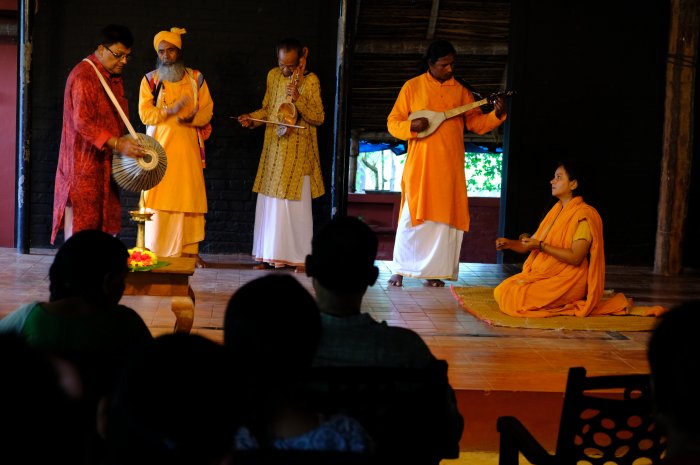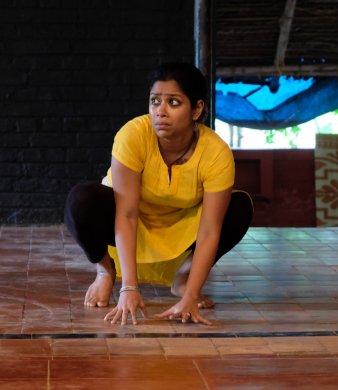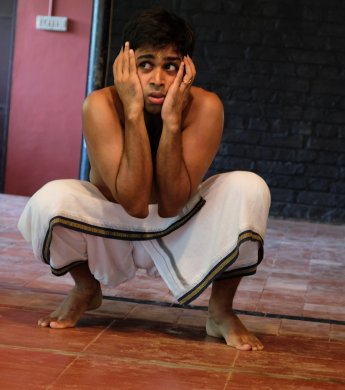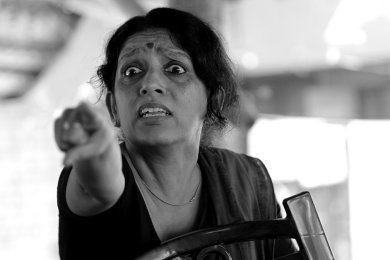
|
 |

|
 |
Evoking Navarasa in you - Devaki Rajendran e-mail: devakirajendran92@gmail.com Photos courtesy: Natanakairali February 23, 2020 The journeys we make and the roads we take lead us to ourselves. This is a thought that constantly lingers in my mind. Every visit to Irinjalakuda and that mandatory visit to Natanakairali fortifies this very thought. The peaceful atmosphere and the palpable energy here, pulls me back again. The last time I visited Natanakairali, I witnessed a series of Koodiyattam performances that enriched me as a lover of art. This time, it completely changed me as a human being and an artist. The experience of the Navarasa Sadhana cannot be expressed in words. It was more than just learning a process. It changed the way I perceived, how I sought inspiration, how I acknowledged things. The Navarasa Sadhana is an intensive practice routine designed for artists from all performance spheres. The workshop is structured in such a way that the participants explore the different layers of the nine rasas in detail and depth. Venuji through years of research and experiments has created this methodology drawing inspiration from the Koodiyattam training, Kodungallur technique of abhinaya, theatre practices from across the world. The workshop began with an informal meeting and inauguration. The 15 member group including me introduced ourselves. We were blessed to listen to the soulful music of Parvati Baul and her group that morning. From here, we began our days of explorations.  Parvati Baul and her troupe performing at the workshop Every day after breakfast we would begin with the eye exercises. The exercises were more than just moving the eyes to different points. It helped build concentration and focus of the mind and helped us build our imagination and observation. We were taught to 'see' and 'show' rather than just look. It is when you start practicing this every day, that you realize the importance and capacity of the eyes. After the eye exercises, we would start with exploring the rasa-s. Before learning the routine for each rasa, we would go out and experience the rasa through the five sensory perceptions, namely sight, touch, sound, odour and taste. The experiences we go through during the exercises are used while executing the rasa. At first it is very difficult to create an effective situation or image, but as we keep going it becomes easier.  Devaki Rajendran (Bharatanatyam dancer) The evening sessions were the improvisations of vyabhicari (transitory) bhava-s. These sessions were the most spontaneous as we did not have a written script. We simply went with the flow in order to experience the different situations. The vyabhicari explored in the first phase is nirvedam which covers the most unpleasant experiences. From poverty, illness, insult, torture, to losing a dear one, we had to go through it all. The evenings when we had to improvise ishtajana viyogam or loss of a dear one, were the most dreaded. Sometimes without dialogue or a plan we would just try to feel the emotion within which made these sessions cathartic, transforming. It subtly changed our reflection and outlook to people, situations. Many of us had never faced this, or placed ourselves in these situations till then which made it significant. Seeing the other acts and participating in them made me think how people would behave to others in certain situations, the mob mentality we all have deep down, so many things I thought were insignificant in me as a person and as a part of a larger group.  Monami Nandy (Odissi dancer)  Sarveshan Kumar (Bharatanatyam dancer) Something I found extremely touching was to see the men break down during some of the improvisations. The most significant lesson I learned from this is to be connected to the emotion, to be sensitive and sympathetic in a larger sense. Being an artist is not just about practicing and performing, it is also about connecting to everything around you, receiving and responding to it and keeping an open mind. As I would always say, attending the workshop is a life changing experience. For two weeks you are pushed out of your comfort zones, exploring situations, emotions, sensations, and thoughts with a large group of artists. The experience is the most important in all of this. More than how beautiful my face looks when I smile, or how much I sit when I become Ravana, I think it is all about what I experience. It is whether I am experiencing the smile within, or am I feeling as mighty as the great Ravana which matters. You are constantly learning even when not in the class, from waking up in the morning, going to the temple, having simple food, sharing our thoughts. It is not that we haven't done any of this before, but during these days we were a lot more sensitive, personally and to each other, that it was almost a fresh experience. Some days were more challenging for me. Being a dancer you are conditioned in a certain way when it comes to experiencing and expressing your emotions. I always felt that the body has been trained to look neat, perfect lines, pleasant face, nothing loud. But during the exercises and learning the routine, we were asked to forget about the body, to make sounds, to experience the emotions. During adbhuta, after sthambhana, we were told to bring out sound of astonishment. It took me nearly five days to make a sound that was convincing to me. Again, in the state of trance during adbhuta we were asked to let go of our inhibitions and use the body to express this state. I was so used to moving my body in a certain way that this was extremely difficult to break that. I felt that performers attach so much importance to the appearance that you will express as long as our form is not disturbed. There, I felt a disconnect between my body, mind, thought and emotion. The eyes are open and we sit in the mandalam, this was another struggle. We had to create an image in our mind and respond to that with complete conviction, all the while sitting with the knees bent. The first few days were tough, almost impossible. But slowly I forgot about the pain because of the sitting, and the open eyes weren't a problem. Instead I enjoyed how I thought beyond the body when I focus on the mind and the image. Like Venuji keeps repeating the need is to create an image so clear that, the body responds to it and to repeat the process every time with truthfulness. When you see it clearly, the body responds. The eyes tear, the eyebrows dance, the face reddens, the breath changes, the body shivers, you produce sound, you smile, etc. It's all in the mind they say, and that's absolutely true. As the days went by, a beautiful connection began to form between the mind and the body. The Sadhana for me was about building and strengthening this connection. The clear mind sees a clear image and the body will respond to it naturally. Every day before starting the routine, we would be asked to focus on the image. Some days your mind is off and it's really tough to create a proper image and you struggle, but other days you transform completely, magically. We were told to be honest about what we feel, even during the improvisations. Forcing the emotions would never create the necessary effect. Sometimes the days were so overwhelming that the effect would remain for hours and days. The most beautiful part of all this is to learn it all from Venuji. He is one of the most humble Gurus, honest, sincere and giving. The vast ocean of knowledge he has acquired through his reading, learning, experimenting makes him stand out in the field of art. His work to popularise Koodiyattam and bring to the forefront the great master Guru Ammannur Madhava Chakyar needs mention every time we speak of him. The knowledge and understanding he acquired through his work and experiences with art from different parts of the world, has helped in the formulation of the Sadhana. Until we experience it first hand, we would never realise how valuable it is. Venuji and his works are an inspiration. For anyone who has heard him speak, even once, there will surely be something to take back. It was a continuous flow of this during the workshop. While teaching, Venuji would tell us stories from his life, from the lives of so many popular artists he has met and so on. Every story, every line, every name he mentions, has value. None of us would forget our pen and book while listening to him, because there is so much information we cannot afford to overlook anything. When it comes to speaking about the class, he would remain quiet. In the beginning I would wonder why he isn't correcting us, why he isn't mentioning any mistakes in how we are executing the rasas. He would conclude every improvisation with a 'Thank You', nothing more, no clapping or discussing. We never wanted to ask him why he wasn't saying anything. If we asked him a doubt he would take time and explain all that we needed. If we had any concern about how we were presenting, he would smile calmly and say, 'You will know it.' And the way he said it gave me confidence.  Meera Gokul (Bharatanatyam dancer)  Meera Sreenarayanan (Bharatanatyam dancer) The most valuable teaching I got from Venuji is to do it, no matter what. One day I was bitten by an insect and had severe itching all over. I had to take medicine and apply lotion and oil, I was really upset. This was in the morning session and we were supposed to finish learning the routine that day. I was rather unsure of what to do, so I went to sir and asked him if I could just sit and watch. Sir enquired if the allergy had subsided and said, 'You have come so far, don't let this stop you from doing the Sadhana.' I think I will always keep those words in my heart. Even after returning home, it's these words that come to my mind when I feel a little tired. The training under Venuji taught me to listen to my instincts. To believe in the thoughts I have, to pay attention to them, question them, and present them with utmost honesty without being concerned with appreciation or criticism. Not only during the workshop, but when we practice our own styles of art, or the Navarasa Sadhana, all we need to do is believe in ourselves and be true to us and the art.  Guru Venuji (fourth from the left) with the participants So, after saying all this about my experiences, I feel the workshop is just a beginning. It is the key to the door that opens to many beautiful paths. The process has been about learning and unlearning, about breaking barriers, going beyond the form and digging deep within myself. It is a continuous process. Like the spiritual journey, you learn, you practice and you experience. Similarly, it is about practicing what I do with honesty and truthfulness. It is not about changing my style of practice, but to refine it with what I have gained through the Sadhana, to strengthen the connection between my mind and body through constant practice.  Kapila Venu performing Nangiarkoothu at the workshop For me the workshop was transforming at every level. The Sadhana workshop under Venuji has opened numerous paths, and possibilities. To be able to practice and perform in front of someone like Venuji, to stand in the kalari where many artists have come and shared their art and to be part of that continuum is an absolute blessing. We were also lucky to attend the Koodalmanikyam temple festival during our workshop. To see great artists from different fields perform and to interact with them was an added benefit. It is very rare to find a place which gives you so much, knowledge, love, perspectives, conflicts, etc. I was prepared for a few things when I went for the workshop, but I returned with so much more. I have never experienced anything so fascinating till now. This is why I hope to return to Natanakairali again, as many times as I can, to attend workshops, to learn, to listen to Venuji and Nirmala Teacher talk, to see Kapila Venu and play with Appu. They say home is where the heart is, and undoubtedly I have left mine in the serene campus of Natanakairali, in Irinjalakuda, in the temple. I wish to go there again to watch more performances, to keep learning more, to question myself, to find myself. I have nothing but profound gratitude for the work conducted in Natanakairali, and I consider myself lucky to have been there and become a part of it in a very small way. I hope my journeys lead me back to this place. Devaki Rajendran is an actress and Bharatanatyam dancer. Post your comments Please provide your name and email id when you use the Anonymous profile in the blog to post a comment. All appropriate comments posted with name & email id in the blog will also be featured in the site. |